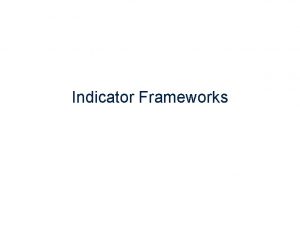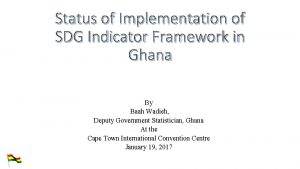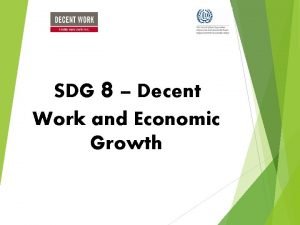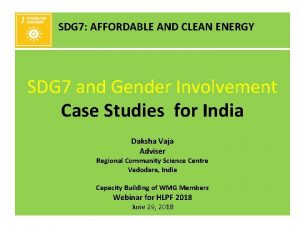NATIONAL SDG INDICATOR FRAMEWORKS STATUS AND NEEDS Mr





- Slides: 5

NATIONAL SDG INDICATOR FRAMEWORKS: STATUS AND NEEDS Mr A. Demberel Director, National Accounts and Research Department, NSO Mongolia 30 -31 May, 2017

I. The role of national statistical systems in national SDG coordination mechanisms A steering committee with 9 working groups has been established under the Prime Minister for SDG implementation/monitoring. Working group for SDG Steering Committee for SDG Prime minister Ministers Management officials other government organizations and agencies §Defining the national monitoring indicators; §Preparing benchmark and target indicators; §Mainstreaming with the national policy documents; 8 working groups §Assessing data availability §Identifying the data sources and methods for estimation of the national and global indicators §Estimating and compiling of the national and global indicators 1 working groups Government and non government organizations, research institutions, and professional associations NSO

II. Mapping national indicator frameworks to the global SDG indicator framework Joint Review of National Data Availability for SDGs by NSO and UNDP in December, 2015 A re-assessment of National Data Availability for SDGS by NSO in March, 2016 SDG indicators Total SDG 241 Not applicable to MGL 13 Number of MGL SDG indicators 228 Status of the indicators Readily available 60 Available after additional calculation 11 Not available 157 • 228 indicators out of 241 in SDGs assumed to be applicable for Mongolia, 71 are available from the current statistical framework. • 157 are not available and needs further research for other potential sources.

II. Mapping national indicator frameworks to the global SDG indicator framework A draft list of national indicators needed to be added to global SDGs Goal № 1 4 5 6 8 9 11 13 14 15 Goals name End poverty in all its forms everywhere Poverty Ensure inclusive and equitable quality education and Education promote lifelong learning opportunities for all Achieve gender equality and empower all women and Gender girls Ensure availability and sustainable management of Water and sanitation water and sanitation for all Promote sustained, inclusive and sustainable economic growth, full and productive employment and decent work Economic for all Build resilient infrastructure, promote inclusive and Infrastructure, sustainable industrialization and foster innovation industry Make cities and human settlements inclusive, safe, Urban resilient and sustainable Take urgent action to combat climate change and its Climate impacts* Conserve and sustainably use the oceans, seas and Lake and water marine resources for sustainable development sources Protect, restore and promote sustainable use of terrestrial ecosystems, sustainably manage forests, Forest combat desertification, and halt and reverse land degradation and halt biodiversity loss Total Number of indicators 8 16 15 8 7 1 1 6 4 6 72

III. Tier 1, 2, and 3 indicators: data availability, quality and challenges Global SDG indicators at the national level, by tiers, as of 21 December, 2016 Goal No. Name of goals 1 End poverty in all its forms everywhere End hunger, achieve food security and improved nutrition and promote sustainable agriculture Ensure healthy lives and promote well-being for all at all ages Ensure inclusive and equitable quality education and promote lifelong learning opportunities for all Achieve gender equality and empower all women and girls Ensure availability and sustainable management of water and sanitation for all Ensure access to affordable, reliable, sustainable and modern energy for all Promote sustained, inclusive and sustainable economic growth, full and productive employment and decent work for all Build resilient infrastructure, promote inclusive and sustainable industrialization and foster innovation Reduce inequality within and among countries Make cities and human settlements inclusive, safe, resilient and sustainable Ensure sustainable consumption and production patterns Take urgent action to combat climate change and its impacts Conserve and sustainably use the oceans, seas and marine resources for sustainable development Protect, restore and promote sustainable use of terrestrial ecosystems, sustainably manage forests, combat desertification, and halt and reverse land degradation and halt biodiversity loss Promote peaceful and inclusive societies for sustainable development, provide access to justice for all and build effective, accountable and inclusive institutions at all levels Strengthen the means of implementation and revitalize the Global Partnership for Sustainable Development 2 3 4 5 6 7 8 9 10 11 12 13 14 15 16 17 TOTAL Targets Indicators Tier 2 1 3 7 7 12 1 4 8 14 2 0 12 13 26 12 3 11 10 11 2 0 9 9 8 5 14 11 6 2 0 2 3 4 0 9 7 4 12 17 6 2 9 8 12 3 1 8 10 10 11 5 11 15 13 7 1 1 0 1 1 1 0 0 9 13 13 6 10 10 0 0 10 12 14 3 0 11 12 23 1 1 21 19 25 0 1 24 169 241 40 18 183 Tier 1: Indicator conceptually clear, established methodology and standards available and data regularly produced by countries Tier 2: Indicator conceptually clear, established methodology and standards available but data are not regularly produced by countries Tier 3: Indicator for which there are no established methodology and standards or methodology/standards are being developed/tested









